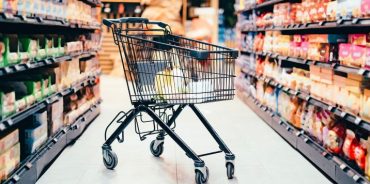Reach, recognition, and relevance: printed point of sale’s persistent appeal
With everything that has been written about the rise of online grocery over the past two years, it can be easy to forget that the vast majority of purchases still take place in store. Even at Tesco, where ecommerce sales have doubled in recent years[1], 86% of sales continue to be made in person – and that’s something that has significant implications for brands when it comes to their media spend.
One of the unique aspects of retail media is that it gives CPGs the ability to advertise to grocery customers at key moments on their shopping journey. And as data science and adtech have become more sophisticated, so too have the opportunities to communicate with shoppers. From sponsored substitutions through to relevant recommendations, brands can now promote their products in organic, relevant, and often additive ways.
As highly valuable as these innovations are, however, in a world where the vast majority of spend on purchasing grocery products continues to be captured in store, it’s critical that we don’t lose sight of traditional methods of mass reach – particularly time-tested techniques like printed point of sale (PPOS).
Enormous reach at a milestone moment
One of the major advantages offered by PPOS is its ability to reach a substantial number of shoppers at once. Audience fragmentation has long been an issue for advertisers, and the increasing digitisation of the media landscape has only compounded that problem. Brands may now have the ability to be more targeted than ever when it comes to their communications, but it is becoming harder than ever to find audiences at scale.
That’s not the case when it comes to store media. While the pandemic prompted many retailers to put a temporary halt on the usage of in-store media, the market has rebounded considerably in the past 18 months. There’s little wonder as to why, either; again taking Tesco as the example, the Tesco Extras and Superstores where a CPG’s printed point-of-sale can be installed welcomes upwards of 11m shoppers every single week.
With the vast majority of those visitors there to make a purchase, PPOS also serves as a final opportunity for brands to sway a sale in their favour. Whether by highlighting the location of their products, reminding shoppers why they like the brand, or carrying a specific call to action like a price promotion, prize offer, or a newly launched product variation or packaging design, strong point of sale material can be an effective motivator at a crucial moment of truth.
Meeting needs by understanding behaviours
The value of printed point of sale as a brand communications tool becomes even clearer when we consider some fundamental truths about the way that we shop. While many of us might like to think that we enter our local grocery shop with a rigid gameplan in mind, the reality is usually a little different.
The results of one recent research study, for instance, suggest that less than half of customers stick to their shopping lists when visiting a store[2]. Additional data shows that almost 90% of us are ready to swap out our planned product purchases for those on promotion[3]. As much as that might say about human psychology, for brands it represents an immense opportunity to nudge shoppers towards new or different products.
Doing that successfully means understanding the specific relationship we have with grocery stores. Unlike an environment like an airport lounge or upmarket shopping centre, a grocery store doesn’t normally hold much in the way of prestige appeal for shoppers. The weekly shop is often a task-driven activity, one that comes down to a matter of utility rather than luxury. That has two implications for the way that point of sale materials can be used.
The first is that there is real value in helping shoppers to be more efficient. PPOS can be highly effective when used to help customers find what they need, provide them with quick inspiration, and highlight the best deals. The second is that customers tend to view (typically more expensive) national brands as a treat when shopping, and so CPGs have a lot to gain by providing customers with the motivation they need to reward themselves.
Adding versatility and value
Important as it is for advertisers to remain in sync with long standing customer behaviours, though, so too is the ability to keep pace with shifting priorities. Today in particular, store media like PPOS has provided brands with an agile and highly visible way of responding to those needs.
Inflation’s recent impact has been well documented; one source suggests that grocery prices have risen by more than 11% year-on-year[4]. And despite easing somewhat since 2020, disruption in the supply chain continues to have an effect on availability. The combined result of those factors is a shopper base that is both actively seeking value, and is ready to switch brands to find it.
In moments like these, PPOS again comes into its own. When shoppers are cutting back, waiting for price promotions, or seeking lower-priced alternatives, PPOS can be used to outmanoeuvre competing brands. At the exact moment that customers are deciding which item to put in their basket, printed media gives you the opportunity to tell them why they should try your brand, remind them why they already love it, or communicate an offer.
Enabling this responsiveness, of course, is the versatility offered by digital print. In days gone by, when litho was the only option, brands were tied to large scale campaigns that needed to be booked and printed well in advance of going live. Today, lower costs and shorter production cycles mean that CPGs can be both more agile and more experimental with their PPOS assets.
While it’s not at the cutting edge of adtech, and nor does it carry the same kind of cachet as something like a cashier-less ‘just walk out’ store, make no mistake: when it comes down to what really matters, PPOS still has it where it counts. And for as long as we continue to buy our groceries in person, that will always be the case.
[1] Tesco Preliminary results 2020/21 – Tesco.com
[2] Shopper Thoughts Module, November 2019
[3] POPAI Shopper Investigation Issue 39
[4] Grocery Inflation Impacts Dollar Channel and Gen Z Consumers Most, Numerator Reports – Numerator, 10 March 2022
TOPICS
RELATED PRODUCTS
A look at dunnhumby’s unique Customer Data Science, which is at the core of everything we do.
Data Science solutionsMake Retail Media work for your business with Customer Data Science
Retail Media solutionsThe latest insights from our experts around the world




